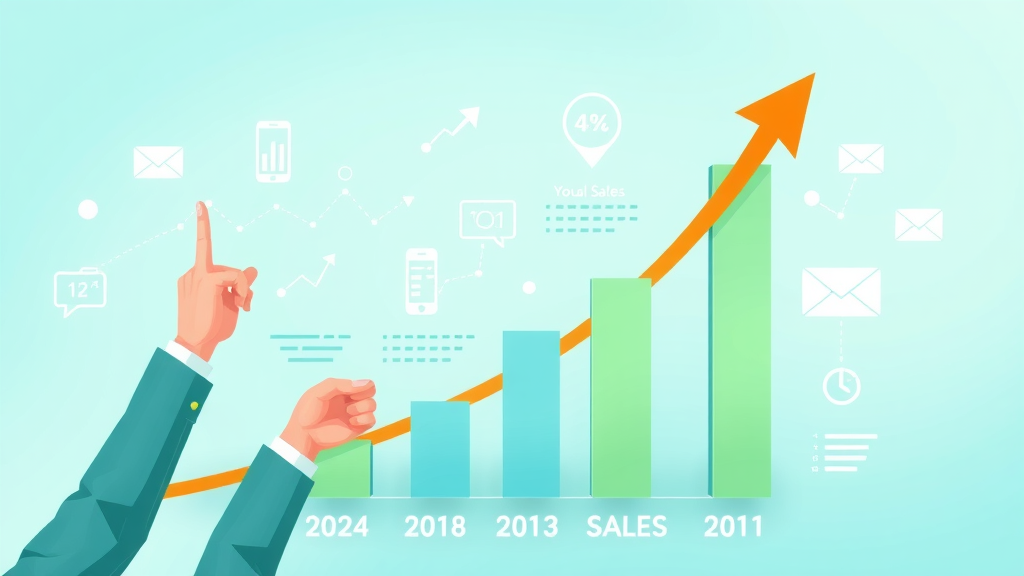
Did you know? Companies embracing digital marketing strategies enjoy up to three times faster revenue growth than their offline-only competitors. If you’re searching for digital marketing strategies that deliver undeniable sales growth—fast—this comprehensive guide peels back the curtain on the proven tactics, tools, and step-by-step approaches backed by real business results. Whether you want more traffic, higher conversions, or stronger brand awareness, you’ll learn how leading brands turn strategy into sales. Get ready for practical advice you can implement today.
Discover How Digital Marketing Strategies Transform Sales—Fast Results Proven by Data
Harnessing digital marketing strategies can revolutionize your business, delivering quick and measurable sales improvements. Leading businesses today leverage integrated digital marketing campaigns that combine social media, content creation, search engine optimization (SEO), and targeted advertising. By analyzing campaign data and adapting in real-time, brands can swiftly identify what resonates with their target audience and optimize for higher conversion rates.
The practical impact? Brands using comprehensive digital strategies not only increase their reach, but also enjoy significant boosts in conversion rates and customer retention. For example, implementing a personalized email marketing strategy has been shown to raise open rates and drive more online purchases. Meanwhile, a seamless blend of social media and search engine marketing creates a pathway for customers to discover, engage, and buy—often within days. The secret? Actionable insights and precise targeting, which accelerate the growth curve faster than traditional approaches.
“Businesses leveraging comprehensive digital marketing strategies experience up to 3x faster revenue growth than their offline competitors.” – Digital Marketing Institute
Unlocking the Power of Digital Marketing Strategies: A Roadmap for Rapid Sales Growth
When you adopt a roadmap built on data-driven digital marketing strategies , you place your business on the fast track to achieving your business objectives. The most successful brands don’t rely on one marketing channel—they build a diversified approach. This often includes identifying your most lucrative digital channels, from social media marketing and email campaigns to influencer and content marketing. Each channel is chosen for its ability to help fulfill key business goals, like boosting brand awareness, driving traffic, or increasing conversions.
An effective digital marketing strategy begins with understanding which channels produce the highest return on investment (ROI) for your specific audience. Brands that continuously monitor marketing performance and adjust their campaigns achieve better results by doubling down on what works. The following guide will walk you through the process of recognizing optimal channels, creating converting campaigns, and optimizing your digital efforts to maximize revenue in record time.
To further refine your approach, consider how local market dynamics and community engagement can amplify your digital marketing results. For actionable insights on leveraging local networks and entrepreneurial communities, explore the resources available at Local Women Entrepreneurs , which offers practical strategies for connecting with your audience and driving growth.
- How to identify your most lucrative marketing channels
- Which digital marketing strategies drive the highest conversion rates
- Steps to develop an effective digital marketing campaign
- Tips for optimizing digital marketing efforts in real time
- Tactics for targeting your ideal buyer persona with precision
Overview of Common Digital Marketing Strategies and Their Average ROI
| Digital Marketing Strategy | Average ROI (%) | Best For |
|---|---|---|
| Social Media Marketing | 95 | Awareness & Engagement |
| Content Marketing | 110 | Thought Leadership |
| Email Marketing | 122 | Conversions & Retention |
| Search Engine Marketing | 113 | High-Intent Leads |
| Influencer Marketing | 85 | Trusted Endorsements |
Why Effective Digital Marketing Strategies Are Essential for Businesses Today
In today’s fast-evolving business environment, effective digital marketing strategies are mission critical. Businesses of every size and industry are moving budgets from traditional advertising to digital channels because of the unparalleled targeting, scalability, and measurable results these solutions provide. Whether your goal is boosting brand awareness, increasing your conversion rate, or building a loyal customer base, a well-crafted digital marketing strategy ensures that your marketing efforts deliver tangible business impact.
The competitive edge lies in the data. Digital channels like social media, paid search, and email marketing equip marketers with the ability to track every click, open, and purchase. As a result, businesses can continually refine their strategies based on what is resonating with their target audience. In 2024 and beyond, companies that invest in robust data-driven marketing efforts outperform those who rely on intuition or outdated tactics, creating a vital foundation for long-term growth.

Digital Marketing: Shaping a Modern Marketing Strategy
The scope of digital marketing today transcends traditional methods, placing emphasis on a multichannel approach that merges creative content, analytics, and technology. A modern marketing strategy integrates all facets of digital marketing—social media, SEO, content marketing, email, and more—allowing seamless customer journeys and aligning every marketing effort with core business goals. This model transforms scattered tactics into a powerful sales engine.
Furthermore, the flexibility of digital channels means you can pivot quickly. If your audience responds better to visual platforms like Instagram or TikTok, swift adjustments can capitalize on trends and maximize engagement. Every successful digital marketing strategy is driven by a blend of data, creativity, and real-time feedback, ensuring your business remains agile and ahead of the curve.
Defining Effective Digital Marketing Strategies for 2024
An effective digital marketing strategy for 2024 is defined by its adaptability and integration of technology. Utilizing tools like AI-driven analytics, customer segmentation, and automation enables brands to reach the right people at the right moment. The best marketing campaigns take advantage of every touchpoint, from social posts to targeted ads, building a holistic and memorable brand experience.
Key elements—like multichannel coordination, data-driven decision making, personalization, and continuous optimization—are no longer optional. They’re necessary for brands aiming to boost their conversion rate and achieve ambitious business objectives. By building your plan around these pillars, you can ensure every dollar spent brings you closer to real, measurable results.
- Multi-channel marketing
- Data-driven targeting
- Personalization
- Integrated analytics
- Continuous optimization
Decoding Your Target Audience and Buyer Persona for Winning Marketing Strategies
Understanding your target audience is the cornerstone of all successful digital marketing strategies. Without a clear grasp of your ideal customer’s demographics, behaviors, and motivations, even the most sophisticated campaigns can fall flat. The process starts with building detailed buyer persona profiles—fictional representations of your perfect customers based on real data and insights.
Segmenting your audience helps you craft highly relevant marketing messages, ensuring every piece of content, every ad, and every email marketing effort speaks directly to the person you’re trying to reach. Brands who excel in this area boast higher conversion rates, stronger customer loyalty, and greater ROI from every marketing channel. Armed with a deeper understanding of your audience, you’ll be equipped to deploy digital marketing strategies that resonate and convert.

How to Identify and Segment Your Buyer Persona
To build effective digital marketing campaigns, start by collecting demographic and behavioral data from your existing customers. Analyze patterns—such as age, gender, location, purchase frequency, and preferred channels—and compare them against your business goals. Next, pinpoint the specific pain points and motivations driving these customers to choose your products and services over competitors.
Mapping your persona’s digital behavior is crucial. Identify where your audience spends their time online: do they frequent Instagram or LinkedIn? Are they interacting with long-form blog posts or quick TikTok videos? Once these details are set, you can create segmented groups and tailor your marketing efforts for maximum relevance and engagement, resulting in higher conversion rates and repeat purchases.
Target Audience: The Cornerstone of Every Digital Marketing Strategy
Every successful digital marketing strategy starts and ends with the target audience. While channel selection and messaging are important, understanding who your ideal customer is—and precisely what motivates them—determines the success of your marketing efforts. Brands who routinely update and refine their buyer persona profiles create campaigns that consistently resonate and drive action.
Recognizing subtle shifts in audience preferences lets your business deliver personalized experiences at scale, improving your marketing campaign’s efficiency and ROI. By putting your target audience front and center, your brand remains customer-centric, creative, and adaptable—key traits required for winning in today’s digital landscape.
- Collect demographic data
- Analyze behavioral patterns
- Pinpoint pain points and motivations
- Map their digital channels of choice
- Create tailored marketing messages
Choosing the Right Digital Marketing Channels for Maximum Impact
Not all digital marketing channels deliver equal results. The key lies in selecting the channels that align best with your objectives, resources, and—most importantly—where your target audience spends their time. For some businesses, social media marketing platforms like Instagram or TikTok are the top performers, while others see greater ROI from search engine marketing or influencer partnerships.
When deciding, analyze where your competitors are thriving, what’s working in your industry, and which platforms facilitate meaningful engagement with your audience. Integrating several top marketing channels—while continuously measuring their performance—is a hallmark of a results-driven digital marketing strategy.

Comparing Top Digital Marketing Channels and Marketing Channels
Understanding how different digital marketing channels work together maximizes reach and impact. Social media marketing is best for rapid brand awareness and direct audience engagement, making it a strong fit for consumer brands and lifestyle products. Content marketing, through blog posts and thought leadership, builds your authority and improves visibility in search engines, attracting high-intent leads.
Email marketing shines for delivering personalized offers and nurturing leads through the sales funnel, while search engine marketing is ideal for capturing warm prospects searching for your solutions. Influencer marketing provides trusted endorsements, helping brands access new audiences and build credibility quickly. Choose a blend of these channels to diversify your marketing effort and mitigate risks as trends shift.
Digital Marketing Channels Matrix
| Channel | Best For | Example Campaign |
|---|---|---|
| Social Media Marketing | Engagement, Brand | Instagram Ads |
| Content Marketing | SEO, Authority | Blog Series |
| Email Marketing | Direct Conversions | Abandoned Cart |
| Search Engine Marketing | High-Intent Leads | Google Ads |
| Influencer Marketing | Trust, Viral Reach | Product Collab |
Launching a High-Impact Digital Marketing Campaign: Step-by-Step Guide
Ready to put your digital marketing strategies into action? The path to launching a successful marketing campaign begins with clear objectives, audience insight, and the right mix of digital channels. Start by defining what success looks like—is it more leads, sales, or market expansion? Next, allocate resources where they’ll drive the most impact, develop compelling content, and set a performance-driven campaign schedule.
The secret to lasting success is regular optimization. By tracking key metrics and responding to real-time performance data, you can quickly pivot, A/B test new ideas, and amplify what’s working. This step-by-step approach ensures every marketing dollar pushes your business closer to its goals, driving rapid, measurable growth.

Setting Measurable Objectives for Digital Marketing Efforts
Every successful digital marketing campaign starts with crystal-clear objectives. Whether your aim is to boost brand awareness, improve your website’s conversion rate, or generate qualified leads, your goals should be specific, measurable, achievable, relevant, and time-bound (SMART). Start by identifying which metrics align with your business goals: for example, tracking click-through rates for email marketing or engagement rates for social media marketing.
By defining these benchmarks upfront, your team can easily determine if the current marketing effort is working or if adjustments are needed. Measurable objectives not only motivate your digital marketing team, they provide actionable direction for every campaign and resource allocation decision. The result is a streamlined, data-driven path to achieving desired outcomes.
Crafting a Digital Marketing Strategy that Converts
A converting digital marketing strategy is rooted in personalization, relevance, and creative storytelling. Begin by addressing your target audience’s biggest pain points and structuring your messages to emphasize real solutions. Use dynamic content, engaging video, and interactive ads to grab attention. With modern marketing tools, you can automate audience segmentation and personalize outreach on a large scale, making every prospect feel like your brand is speaking directly to their needs.
Test different creative formats and calls-to-action based on campaign analytics. Iterate quickly—what resonates with one segment may not work for another. Layer on seasonal promotions or influencer partnerships to spike urgency and social proof. Finally, review results regularly—analyze which marketing channels, messages, or ad formats are outperforming. This ongoing optimization builds a future-proof digital marketing strategy that remains effective regardless of shifting trends.
- Define campaign goals
- Select digital marketing channels
- Allocate budget and resources
- Develop compelling content
- Schedule campaign timeline
- Analyze and optimize regularly
Optimizing Your Marketing Strategy: Data-Driven Digital Marketing Solutions
Continual improvement is the secret to sustained digital marketing success. Embracing data-driven solutions lets marketers see exactly what’s working—and what isn’t—in real time. From tracking website traffic and conversions to monitoring social engagement and ad spend, every piece of data uncovers insights that power more effective marketing strategies.
Actions as simple as A/B testing landing pages or adjusting email marketing content based on open rates can significantly improve your campaign’s conversion rate. The most adept marketing teams use these insights to double down on high-performing tactics, pause underperformers, and experiment intelligently with new ideas—turning data analytics into real revenue.

Essential KPIs for Effective Digital Marketing
Tracking the right KPIs (key performance indicators) is pivotal to measuring your marketing strategy’s success. Common metrics include website traffic, conversion rate, cost per acquisition (CPA), return on ad spend (ROAS), and customer lifetime value (CLV). For social media marketing, focus on engagement rates, reach, and new followers. Email marketing should emphasize open, click, and unsubscribe rates.
Choosing KPIs that align with your business objectives ensures you’re not just collecting data, but gathering actionable insights. Regularly review your dashboard and use what you learn to refine your digital marketing strategy for better results. Remember, the fastest-growing brands let data—not assumptions—shape every major marketing decision.
Boosting Conversion Rate Through Refined Digital Marketing Efforts
Refinement is at the heart of conversion optimization. Analyze your funnel: where are prospects dropping off? Use that intel to test new landing pages, update copy, or try fresh creative assets. Often, even small tweaks—like simplifying your forms or offering a compelling call-to-action—can substantially increase your conversion rate.
Leverage split testing and heat mapping tools to uncover subtle trends. Focus marketing efforts on advancing prospects to the next stage of the funnel, from awareness to purchase. The continuous cycle of analyzing, testing, and optimizing is what transforms good digital marketing strategies into sales-driving powerhouses.
“Marketing without data is like driving with your eyes closed.” – Dan Zarrella
Leveraging Social Media Marketing as a Core Marketing Strategy
Social media marketing remains a core pillar of every winning digital marketing strategy . Its versatility and reach allow brands to foster direct communication with prospective and existing customers, showcase products and services, and cultivate brand loyalty in real time. The best campaigns take an omnichannel approach, connecting Instagram, Facebook, LinkedIn, TikTok, and other platforms for cohesive storytelling and engagement.
Brands that master social media marketing harness user-generated content, influencer partnerships, and interactive features to build credibility and spark viral interest. These interactive and authentic experiences drive not only awareness, but measurable sales growth. Track key metrics and refine your approach to maximize the power of social media as a lead generation engine.
Best Practices for Multi-Channel Social Media Marketing
Start by creating a unique tone of voice and visual brand identity for each platform, while ensuring overall consistency. Schedule content during peak engagement times and use analytics to determine what topics or formats your audience prefers. Mix evergreen educational posts with trending content and behind-the-scenes glimpses to humanize your brand.
Collaborate with influencers who have genuine authority in your niche, leverage platform-specific features such as Instagram Reels or LinkedIn articles, and always respond authentically to comments and messages. The ongoing feedback loop from these activities feeds your entire digital marketing strategy with insights on what truly resonates.
Content Marketing Hacks: Fuel Your Social Media Campaigns
Content marketing and social media go hand in hand. Repurpose blog posts, customer testimonials, case studies, and industry data into short videos, infographics, and shareable graphics—keeping your feed both informative and visually engaging. Use compelling hooks in the first few seconds of a video or the first line of a caption to capture attention quickly.
Experiment with interactive stories, polls, and live Q&As to transform passive followers into active participants. Curated content and behind-the-scenes peeks help foster a sense of community and authenticity, which drives higher engagement and more repeat business through social channels.

- User-generated content contests
- Live video product demos
- Seasonal engagement campaigns
- Influencer partnerships
- Polls and Q&As
Mastering Email Marketing Within Your Digital Marketing Strategy
Email marketing remains one of the highest ROI marketing channels for generating conversions and customer loyalty. A robust email marketing strategy combines personalized messaging, timely delivery, and automation to guide subscribers down the sales funnel. It provides an unmatched platform for re-engagement, upselling, and exclusive promotions.
Segmenting your audience ensures that each campaign is highly relevant, increasing open and click-through rates and reducing unsubscribes. Invest in tools that tailor content to recipient behavior—such as personalized product recommendations and triggered email sequences—and watch your conversion rate soar.
Personalization Tactics to Transform Email Marketing Performance
True personalization in email marketing means more than just adding a first name—it demands messages crafted around past behaviors, preferences, and lifecycle stages. Use dynamic content blocks to serve individualized product suggestions, send reminders based on abandoned carts, and align offers with key events or holidays relevant to each segment.
Advanced automation tools help marketers deliver these experiences at scale, keeping audiences engaged and moving through the sales funnel. Consistent optimization, testing different subject lines, layouts, and offers, will further improve performance and customer retention.

Segmenting Your Audience for Targeted Campaigns
Audience segmentation is the secret weapon powering high-conversion email campaigns. Start with broad categories—such as new vs. existing customers—then get granular based on purchase history, engagement levels, and even location or interests. This enables not just better targeting, but better insights on what each audience segment values most.
Refine your email marketing strategy by continuously updating these segments as new data comes in—making every touchpoint feel intentional and personalized. Over time, these targeted campaigns not only heighten customer satisfaction but also reduce churn and accelerate revenue growth.
- Welcome sequences
- Cart abandonment reminders
- Holiday promos
- Regular newsletters
Supercharging Sales with Search Engine Marketing and SEO-Based Digital Marketing Strategies
Visibility on search engines remains fundamental for driving high-intent leads and converting them to customers. Combining organic SEO tactics—like keyword optimization, technical enhancements, and link building—with paid search (PPC) campaigns creates a dominant search engine presence, capturing buyers at every stage of the funnel.
Businesses that integrate their SEO and PPC strategies see not only higher rankings but also increased credibility in search results. From long-tail keywords to conversion-optimized landing pages, a balanced search engine marketing strategy will continuously bring qualified traffic—and more sales—to your digital doorstep.
Integrating SEO and PPC for Dominant Search Engine Presence
The smartest marketers use SEO and PPC together for greater coverage and insights. While SEO builds lasting authority and organic rankings, PPC provides instant traffic for top-converting keywords. Cross-reference analytics from both to determine high-value terms, then allocate budget towards paid ads that supplement your best organic listings.
Use PPC campaigns to test new offers or landing pages, then roll over that intel into your SEO content strategy. Conversely, high-performing organic content can inform PPC campaign creative and keyword selection. This integration ensures your brand appears at every step of the customer journey—maximizing both ROI and conversion rates.

Keyword Research: The Backbone of Search Engine Campaigns
Robust keyword research is the linchpin for successful search engine campaigns. Start with long-tail keywords to capture intent and reduce competition, then expand into broader high-volume terms over time. Tools like Google Keyword Planner or SEMrush reveal what prospects are searching for, along with related questions and trends.
Focus on user intent, incorporating keywords into on-page elements like meta titles, headers, and CTAs. Updating and expanding your keyword list as market trends shift ensures evergreen relevance. A data-driven approach to keyword research not only improves your organic rankings but also lowers cost per click in paid campaigns, multiplying your marketing impact.
- Long-tail keyword targeting
- High-quality link building
- On-page optimization
- Conversion-optimized landing pages
Aligning Content Marketing With Your Digital Marketing Strategies
The best digital marketing strategies are built around a robust content marketing engine. High-value content—whether in the form of blog posts, videos, infographics, or podcasts—fuels SEO, engages your social audience, and nurtures prospects throughout the funnel. A strategic approach to content ensures that every piece has a purpose, aligns with your audience’s needs, and directly supports business objectives.
Diversity is key. Mix educational resources, entertaining segments, and actionable guides tailored to buyer personas at various stages of consideration. With an editorial calendar tied to your digital marketing strategy, you’ll maintain consistent production and maximize ROI across all channels.
Developing a High-ROI Content Calendar
A content calendar acts as the blueprint for your marketing strategy. Plan content ahead of time around product launches, seasonal events, and trending industry topics. Align each post with a funnel stage—awareness, consideration, or conversion—to ensure a seamless journey from first touch to final sale.
Measure which content types drive the most engagement and conversion, then adjust your schedule accordingly. Great calendars also include room for spontaneity—allowing you to capitalize on viral trends or address newsworthy events in real time.

Maximizing Engagement Through Content Variety
Audiences crave diverse formats. Blog articles establish authority and boost SEO, videos communicate complex ideas quickly, and infographics simplify data into shareable, visual nuggets. Podcasts and case studies bring relatable stories to life, fostering deeper trust with your brand.
By mixing content types, you appeal to various learning styles and consumption habits—broadening your reach and improving engagement rates. This variety also provides ample material for repurposing across digital marketing channels, amplifying your brand’s presence without overwhelming your creative team.
- Blogs
- Videos
- Infographics
- Case studies
- Podcasts
Real-Time Analytics and Continuous Improvement in Digital Marketing Efforts
Real-time analytics turn digital marketing from guesswork into a science. Platforms like Google Analytics reveal which sources drive the most traffic, which pages convert best, and where prospects drop off. Integrating these insights into your ongoing campaigns accelerates growth and sharpens competitive advantage.
Continuous improvement requires not just reviewing historical data but acting on live trends. Set clear benchmarks, automate reporting, and empower your team to make quick, data-informed decisions that optimize every element of your marketing strategy.
The Role of Analytics in Shaping Marketing Strategy
Analytics should be the compass for every digital marketing decision. Detailed dashboards reveal user journeys, campaign attribution, and ROI for each channel. By segmenting performance data, marketers can spot anomalies and identify underutilized opportunities.
A data-driven marketing strategy fosters a culture of curiosity and experimentation, where every marketing effort informs the next. This approach not only keeps your campaigns agile—it bakes continual improvement and innovation into the DNA of your business.

Optimizing Marketing Campaigns with Data-Driven Decisions
The cycle of campaign optimization is powered by data at every stage. Launch, track, analyze, and refine—repeat. When a piece of content outperforms, duplicate the formula; when something flops, investigate the “why” and adapt quickly.
Create a process for regularly reviewing analytics dashboards, sharing insights across teams, and experimenting with new creative approaches. Over time, this practice compounds incremental gains into remarkable overall performance, allowing your digital marketing strategy to evolve with your business and industry.
Analytics Dashboard Comparison
| Platform | Key Insights Provided | Best Use Case |
|---|---|---|
| Google Analytics | Traffic & Conversion data | Website Performance |
| HubSpot | Marketing & Sales insights | Integrated Campaigns |
| Sprout Social | Social Engagement Analytics | Social Strategy Tracking |
Common Digital Marketing Strategies Questions: People Also Ask
What are the four digital marketing strategies?
Explore social media marketing , content marketing , search engine marketing , and email marketing —the core pillars that form the foundation of nearly every successful digital marketing strategy. These channels work in harmony to maximize your reach and results.
What are the 7 types of digital marketing?
The seven types include social media marketing , email marketing , content marketing , search engine optimization (SEO) , pay-per-click (PPC) advertising , affiliate marketing , and influencer marketing . Each addresses a different aspect of a holistic digital marketing strategy, ensuring comprehensive audience engagement.
What are the 5 S's of digital marketing?
The 5 S’s stand for Sell, Serve, Speak, Save, and Sizzle —core objectives guiding effective digital marketing strategies to maximize business impact. Each “S” represents a different way to engage with customers and create value online.
What are the 7 C's of digital marketing?
The 7 C’s refer to customer, content, context, community, convenience, cohesion, and conversion —key elements necessary for powerful digital marketing strategies. Implementing each ensures your efforts are focused, relevant, and built for maximum ROI.
Most Frequently Asked Digital Marketing Strategies FAQs
-
How quickly do digital marketing strategies show real sales results?
While some channels like PPC and influencer marketing can generate leads within days, building momentum for content or SEO strategies may take several months. Consistent optimization speeds up the sales impact regardless of channel. -
What digital marketing channel is most cost-effective for beginners?
Email marketing is often the most cost-effective starting point thanks to low overhead and high ROI—especially when combined with social media strategies for list building. -
How do I measure the ROI of my digital marketing strategy?
Track metrics such as lead generation, sales conversions, average order value, and customer lifetime value. Tools like Google Analytics and HubSpot simplify calculation and reporting of marketing ROI. -
Can I integrate offline and online marketing strategies?
Yes, blending tactics like events, print, or out-of-home with your digital strategy creates a more holistic customer experience and magnifies campaign impact when well-coordinated. -
What is the best content type for high conversion rates?
Landing pages with clear calls-to-action, video product demos, and customer case studies tend to convert at higher rates—especially when personalized to your buyer persona.
Modern Digital Marketing Strategies in Action: Success Stories and Case Studies
- Retail brand increases sales 150% with multi-channel digital marketing campaign
- SaaS company doubles conversions by optimizing email and content marketing
- B2B manufacturer grows lead pipeline 3x using integrated marketing strategy
Five Key Takeaways: Building a Winning Digital Marketing Strategy
- Prioritize understanding your target audience and buyer persona
- Mix and match digital marketing channels to optimize reach
- Focus on content that adds value to your marketing efforts
- Test, measure, and iterate for ongoing marketing strategy success
- Leverage data-driven insights for continual improvement
Accelerate Your Sales with Advanced Digital Marketing Strategies
- Ready to put powerful digital marketing strategies into action? Start crafting your custom plan, measure your results, and watch your sales grow faster than ever.
Take your next step: Define your buyer persona, choose your prime marketing channels, map your content, test often, and let analytics drive every campaign for rapid sales growth.
If you’re inspired to elevate your digital marketing strategy even further, don’t stop here. The journey to sustainable growth is ongoing, and the most successful entrepreneurs continually seek out new perspectives and advanced tactics. For a broader look at how innovative women are transforming their businesses and communities through digital marketing, visit Local Women Entrepreneurs . There, you’ll discover stories, resources, and strategic insights that can help you unlock fresh opportunities and take your marketing—and your business—to the next level.
To further enhance your understanding of effective digital marketing strategies, consider exploring the following resources:
- “A Comprehensive Digital Marketing Strategy: 10 Steps” ( newtarget.com )
This article outlines a structured approach to building a robust digital marketing plan, covering essential components such as pay-per-click advertising, affiliate marketing, and video marketing.
- “10 Online Marketing Strategies You Can Launch Right Now” ( business.adobe.com )
This resource provides actionable insights into various online marketing tactics, including email marketing, content marketing, and social media marketing, to help you quickly implement strategies that drive results.
By delving into these articles, you’ll gain practical knowledge and step-by-step guidance to effectively implement digital marketing strategies that can boost your sales rapidly.
 Add Row
Add Row  Add
Add 




Write A Comment